Adroddiad sefyllfaol COVID-19: 22 Gorffennaf 2021
Diweddariad gan Gell Wybodaeth COVID-19 a'r Grŵp Ymgynghorol Diogelu Iechyd.
Efallai na fydd y ffeil hon yn gyfan gwbl hygyrch.
Ar y dudalen hon
COVID-19 situation report summary
Key points to note
O 17 Gorffennaf ymlaen, mae Cymru ar Lefel Rhybudd 1. Bwriedir symud Cymru i Lefel Rhybudd 0 ar 7 Awst.
Mae trosglwyddiadau cyffredinol COVID-19 yn parhau i gynyddu mewn llawer o ardaloedd ar draws Cymru, er bod yr achosion yn awr yn lleihau mewn sawl ardal neu’n fwy neu lai’n sefydlog o ran y newid wythnosol. Mae amcangyfrif consensws y Grŵp Cynghori Gwyddonol ar Argyfyngau (SAGE) ar gyfer y rhif atgynhyrchu yng Nghymru rhwng 1.2 a 1.4, tra bod amcangyfrif Iechyd Cyhoeddus Cymru (PHW) rhwng 1.3 ac 1.4. Ffynhonnell: SAGE / PHW (21/7/21). Sylwer bod fel arfer oedi o 2 i 3 wythnos yn amcangyfrif SAGE a bod oedi yn achos amcangyfrif PHW, sy’n defnyddio methodoleg wahanol, o tua 1 wythnos. Mae’r digwydded achosion a chanran y bobl sy’n profi’n bositif am COVID-19 hefyd wedi cynyddu. Sleid 3, Ffynhonnell: PHW.
Mae’r pwysau sydd ar y GIG oherwydd COVID-19 wedi bod yn cynyddu’n raddol dros yr wythnosau diwethaf. Fel yr oedd ar 21 Gorffennaf 2021, roedd 176 o gleifion sy’n gysylltiedig â COVID-19 (Amheuaeth, Cadarnhawyd, a oedd yn Gwella) yn defnyddio gwely mewn ysbyty, cynnydd o 26 ers yr wythnos flaenorol. Mae 26 o gleifion y mae Amheuaeth neu y Cadarnhawyd bod ganddynt COVID-19 mewn gwelyau gofal critigol yng Nghymru. Cyfanswm nifer y cleifion mewn gofal critigol oherwydd COVID-19 ac am resymau nad ydynt yn gysylltiedig â COVID-19 yw 166, 14 yn fwy nag uchafswm capasiti gofal critigol cyn y pandemig o tua 152.
Ar 20 Gorffennaf 2021, mae’r achosion a gadarnhawyd o’r amrywiolyn Delta, sef yr amrywiolyn amlycaf, yn 7,817 yng Nghymru (mae hyn yn gynnydd o 2,216 ers yr wythnos flaenorol). Ni chanfuwyd unrhyw amrywiolyn sy’n peri pryder arall. O’r 7,817 o achosion a ganfuwyd hyd yma, roedd 47.5% o’r achosion mewn unigolion nad ydynt wedi’u brechu, roedd 30.8% wedi derbyn 1 dos ac roedd 21.7% wedi derbyn 2 ddos. Sylwer efallai fod y data hyn yn cynnwys brechiadau nad oes 14 i 21 o ddiwrnodau, fel sy’n angenrheidiol i ddarparu’r amddiffyniad gorau posibl rhag COVID-19, wedi pasio ers iddynt gael eu derbyn. O’r 7,817 o achosion, cafodd 99, neu 1.3%, eu derbyn i’r ysbyty. Ffynhonnell: PHW.
O ran brechu, ar 21 Gorffennaf 2021, mae cyfanswm o 4.24 (+0.11) miliwn o ddosau o frechlyn COVID-19 wedi cael eu rhoi yng Nghymru. O’r rhain, dosau cyntaf oedd 2.28 (+0.01) miliwn ac ail ddosau oedd 1.96 miliwn (+0.10). Yn seiliedig ar amcangyfrifon SAGE, ei bod yn ofynnol bod o leiaf 80% o’r boblogaeth wedi’i brechu er mwyn ymateb i’r amrywiolyn Delta, os na cheir unrhyw ymddygiadau amddiffynnol eraill, ni fydd y niferoedd presennol sydd wedi’u brechu yn diogelu ar lefel y boblogaeth gyfan. Ffynhonnell: PHW, SPI-M-O
Dangosyddion allweddol
Mae nifer o ddangosyddion allweddol yn dangos cynnydd, yn dilyn cyfnod lle cafwyd lefel isel o drosglwyddiadau ym mis Ebrill a Mai.
Sylwer bod y saethau yn cynrychioli newid mewn cymhariaeth â’r wythnos ddiwethaf.
| Gwerth cyfredol (17/7/21) | Newid ers yr wythnos flaenorol (10/7/21 i 17/7/21 oni nodir fel arall) | ||||
| Newid mewn canran | Newid mewn gwerth | ||||
| Cyfradd yr achosion a gadarnhawyd (swm 7 diwrnod treigl fesul 100k) | 188 | +25% | ↑ | (+38) | |
| Cyfradd achosion a gadarnhawyd yn y rheini dros 60 oed (swm 7 diwrnod treigl fesul 100k) | 55 | +49% | ↑ | (+18) | |
| Positifedd profion (Cyfartaledd treigl 7 diwrnod) | 10.6% | +34% | ↑ | (+2.7 pwynt canran) | |
| Y boblogaeth yr amcangyfrifir bod ganddi COVID-19 (cyffredinrwydd)1 | 0.47% | +68% | ↑ | (+0.19 pwynt canran) | |
| Derbyniadau COVID-19 y GIG2 | 13 | +44% | ↑ | (+4) | |
| Marwolaethau ONS (swm 7 diwrnod)3 | 1 | 0% | - | 0 | |
| Marwolaethau PHW (swm 7 diwrnod) | 8 | +167% | ↑ | (+5) | |
- Mae’r data diweddaraf a gafwyd o’r Arolwg Heintiadau COVID-19 ar gyfer y cyfnod o 11 Gorffennaf 2021 i 17 Gorffennaf 2021.
- Y cyfartaledd treigl saith diwrnod hyd at y dyddiad presennol o gleifion y cadarnhawyd bod ganddynt COVID-19, nid yw’n cynnwys cleifion y mae amheuaeth bod ganddynt COVID-19 neu sy’n gwella.
- Mae data marwolaethau diweddaraf ONS hyd at 9 Gorffennaf 2021 (yn hytrach na 17 Gorffennaf 2021) ar gyfer y gwerth cyfredol. Defnyddir data hyd at 2 Gorffennaf 2021 ar gyfer y newid ers yr wythnos flaenorol.
What is the current status of the epidemic?
| Local Authority | Number | % of All Wales Total | Case Incidence per 100,000 | Incidence threshold reached | Change from previous week |
|---|---|---|---|---|---|
| Denbighshire | 472 | 7.90% | 493.2 | 50 or higher | 116% ↑ |
| Conwy | 415 | 6.90% | 354.1 | 50 or higher | 84% ↑ |
| Wrexham | 440 | 7.30% | 323.6 | 50 or higher | 1% ↑ |
| Flintshire | 457 | 7.60% | 292.8 | 50 or higher | 32% ↑ |
| Bridgend | 405 | 6.80% | 275.4 | 50 or higher | 61% ↑ |
| Powys | 318 | 5.30% | 240.1 | 50 or higher | 51% ↑ |
| Torfaen | 208 | 3.50% | 221.4 | 50 or higher | 18% ↑ |
| Cardiff | 706 | 11.80% | 192.4 | 50 or higher | 10% ↑ |
| Monmouthshire | 171 | 2.90% | 180.8 | 50 or higher | 40% ↑ |
| Rhondda Cynon Taf | 406 | 6.80% | 168.3 | 50 or higher | 20% ↑ |
| Newport | 255 | 4.30% | 164.9 | 50 or higher | 17% ↑ |
| Vale of Glamorgan | 217 | 3.60% | 162.4 | 50 or higher | 29% ↑ |
| Merthyr Tydfil | 85 | 1.40% | 140.9 | 50 or higher | 57% ↑ |
| Swansea | 329 | 5.50% | 133.2 | 50 or higher | 66% ↑ |
| Gwynedd | 150 | 2.50% | 120.4 | 50 or higher | -5% ↓ |
| Caerphilly | 215 | 3.60% | 118.7 | 50 or higher | 3% ↑ |
| Blaenau Gwent | 82 | 1.40% | 117.4 | 50 or higher | 30% ↑ |
| Isle of Anglesey | 82 | 1.40% | 117.1 | 50 or higher | -6% ↓ |
| Ceredigion | 79 | 1.30% | 108.7 | 50 or higher | 11% ↑ |
| Pembrokeshire | 134 | 2.20% | 106.5 | 50 or higher | 81% ↑ |
| Neath Port Talbot | 143 | 2.40% | 99.8 | 50 or higher | 17% ↑ |
| Carmarthenshire | 177 | 3.00% | 93.8 | 50 or higher | 5% ↑ |
| Unknown | 47 | 0.80% | - | 31% ↑ | |
| Total | 5993 | 100.00% | 190.1 | 50 or higher | 31% ↑ |
At a Wales level, on 16 July, the 7-day rolling incidence of COVID-19 cases and the percentage of people testing positive for COVID-19 have increased since last week .
The SAGE/ SPI-M consensus estimate of Reproduction number (Rt) is between 1.2 and 1.4 (as at 21 July 2021), with a doubling time of 10 to 19 days. When we look at reproduction numbers using PHW positive test data only (see second table below), a more timely estimate but limited by variation in testing, we see an Rt of between 1.3 and 1.4 for Wales and a national doubling time of 14 days. When R is above 1.0, the pandemic is growing. Rt is highest for Swansea Bay, Cwm Taf Morgannwg and Powys health boards. PHW central estimates of doubling times at health board level range from 10 to 25 days. Source: SAGE/ PHW.
7-day cumulative case incidence in Wales has increased by a third in the last week. Case incidence has risen to 190.1 per 100,000 population in Wales compared with 145.5 per 100,000 population last week.
Case incidence is increasing in almost all local authorities. All 22 local authorities have a case incidence above the 50 per 100,000 population threshold. Local authorities with the highest case incidences are in North Wales. Case incidence is highest for Denbighshire and Conwy at 493.2 and 354.1 per 100,000 population, respectively.
Case incidence is highest in those aged 10 to 19 and 20 to29. Case incidence continued to increase throughout the week in these age groups. Case incidence is highest for the Betsi Cadwaladr health board.
The second table below provides estimates of doubling and halving times based on PHW COVID-19 positive test data. In this table, doubling times are positive, whilst halving times are negative. The 95% confidence intervals are showing in brackets after the central estimate. An asterisk (*) means that there are small numbers and estimates should be treated with caution. Local health board level estimates of Rt and halving times will be unstable when incidence is low.
| Area | Rt (95% CI) | Doubling time (95% CI) |
|---|---|---|
| All Wales | 1.3 (1.3 to 1.4) | 14 (10 to 23) |
| Swansea Bay UHB | 1.4 (1.3 to 1.5) | 10 (7 to 21) |
| CTM UHB | 1.4 (1.3 to 1.4) | 12 (8 to 26) |
| Aneurin Bevan UHB | 1.2 (1.1 to 1.2) | 20 (12 to 79) |
| Cardiff & Vale UHB | 1.2 (1.1 to 1.2) | 25 (14 to 122) |
| Hywel Dda UHB | 1.3 (1.2 to 1.4)* | 13 (7 to 39)* |
| Powys THB | 1.4 (1.3 to 1.6)* | 10 (7 to 21)* |
| Betsi Cadwaladr UHB | 1.3 (1.3 to 1.4) | 16 (11 to 28) |
Cases per 100k (PHW Data) (7 day rolling sum)
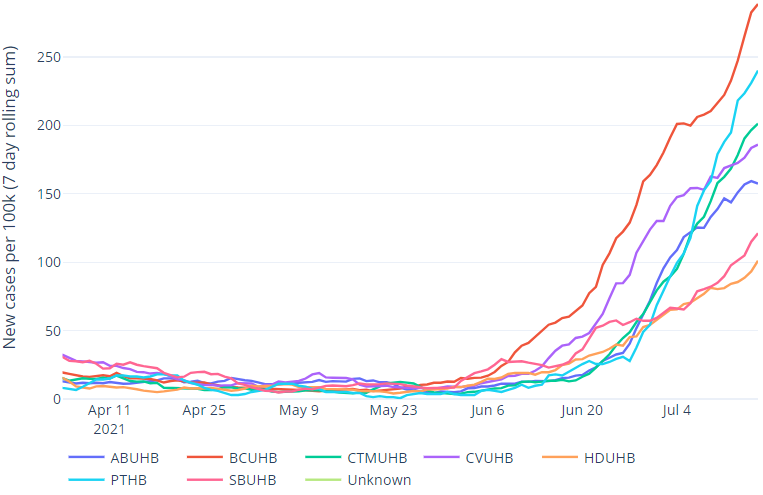
Cases per 100k by age (PHW Data) (7 day rolling sum)

Data as at 12:00PM 21 July 2021 unless otherwise specified.
What is the situation with the NHS and social care?
COVID-19 pressure on the NHS has been steadily increasing over recent weeks. As at 21 July 2021, there were 176 COVID-19 related patients (Suspected, Confirmed and Recovering) occupying a hospital bed. This compares to 150 (26 more occupied beds) on 14 July 2021. Confirmed patients accounted for 110 of the total occupied beds, and are at similar levels to early April 2021.
There are 26 patients with Suspected or Confirmed COVID-19 in critical care beds in Wales. This is 138 lower than the maximum COVID-19 position of approximately 164. The total number of patients in critical care for both COVID-19 and non-COVID-19 stands at 166, 14 more than the historic maximum critical care capacity of approximately 152.
In the 7 days up to 14 July 2021, 40 (3.8%) adult care homes in Wales notified CIW of one or more confirmed cases of COVID-19, in staff or residents. This is 13 more notifications compared to the 7 days up to 7 July 2021 and compares to 4 notifications in the 7 days up to 2 June 2021, which was the lowest number of notifications since reporting began on 16 December 2020.
Confirmed hospital occupancy (7 day rolling average)
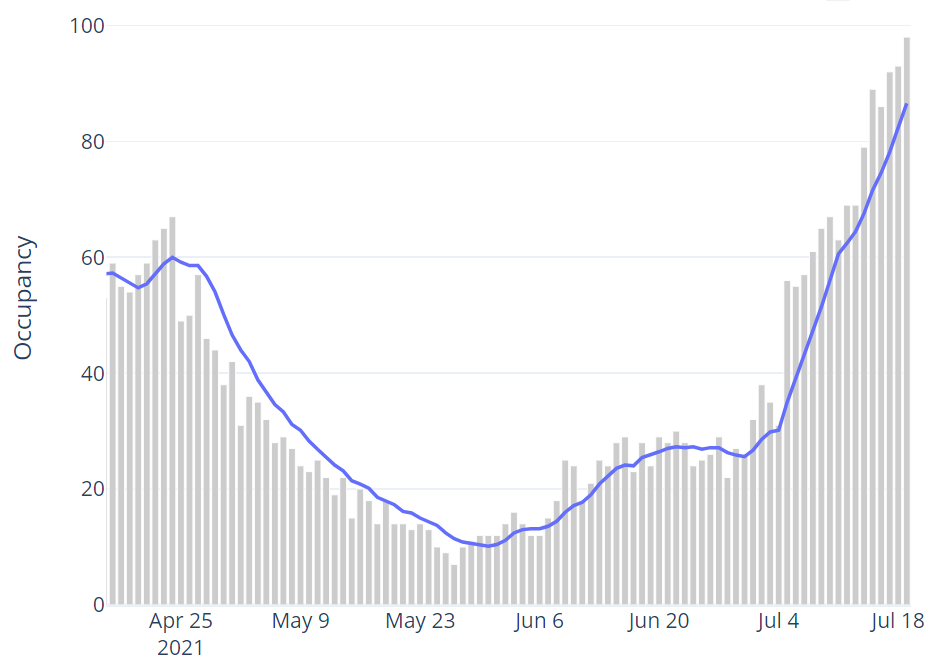
Overall invasive ventilated bed occupancy (7 day rolling average)
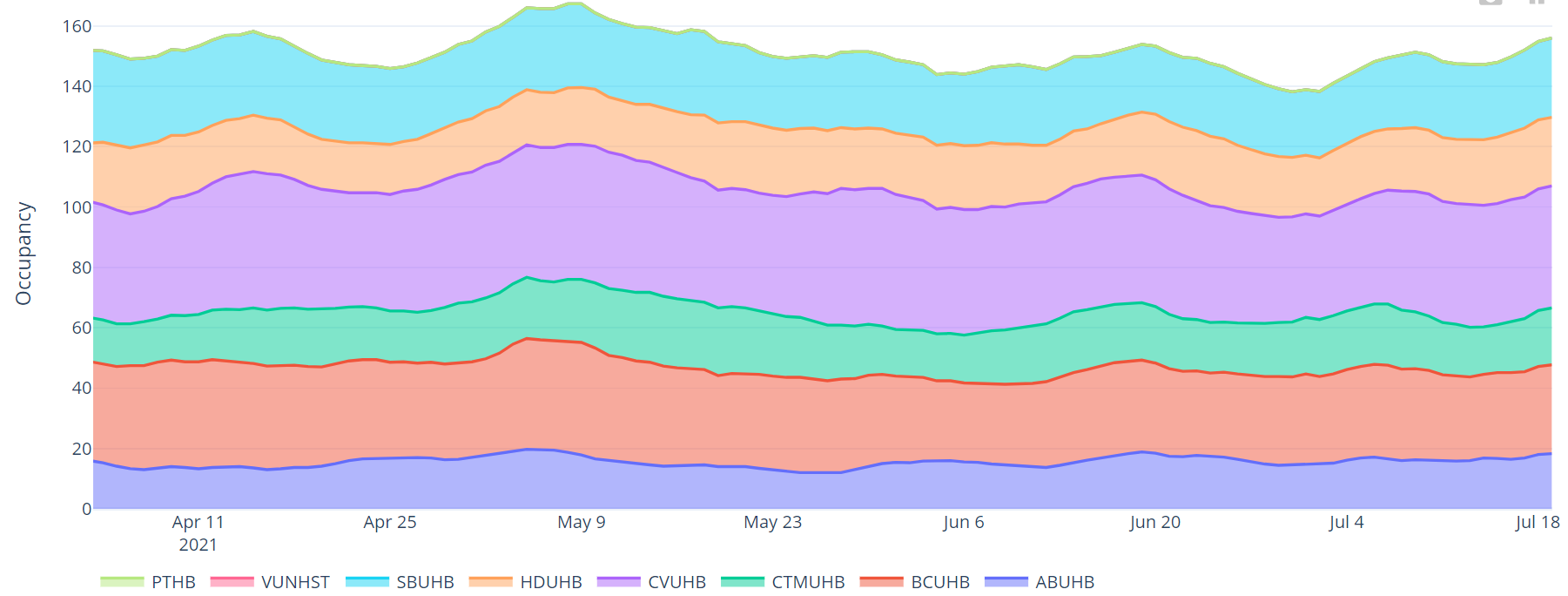
Hospital bed occupancy for suspected and confirmed COVID-19 positive patients (7 day rolling average)
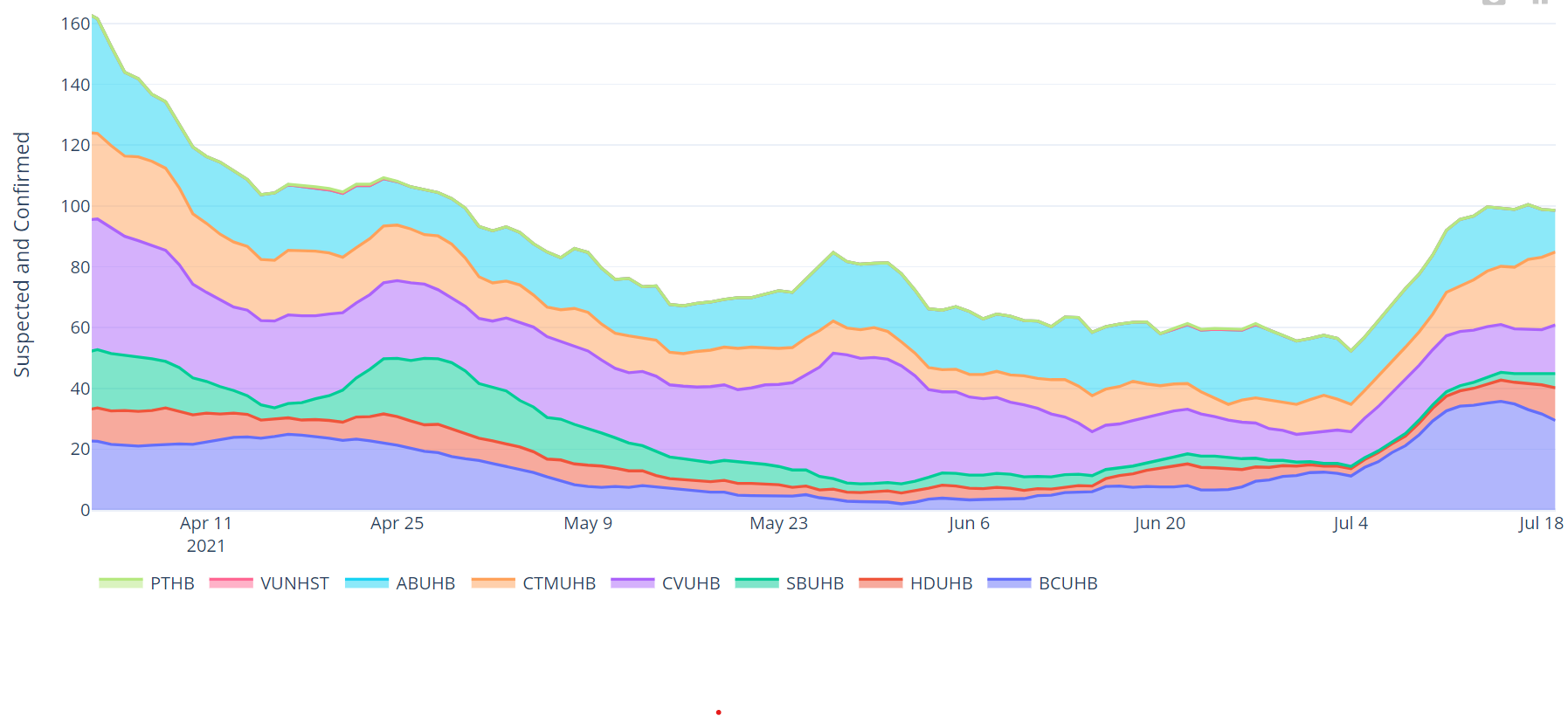
Invasive ventilated bed occupancy for suspected and confirmed COVID-19 positive patients (7 day rolling average)
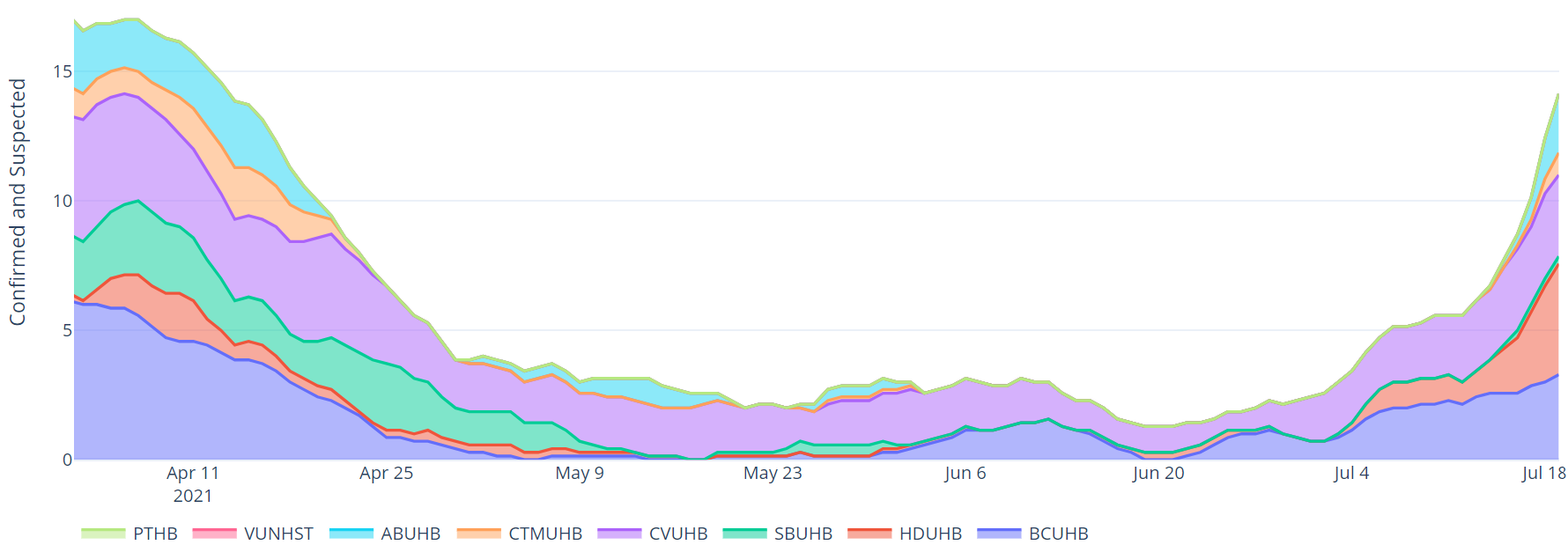
Number of adult care homes reported an ongoing outbreak/incident (last 7 days)
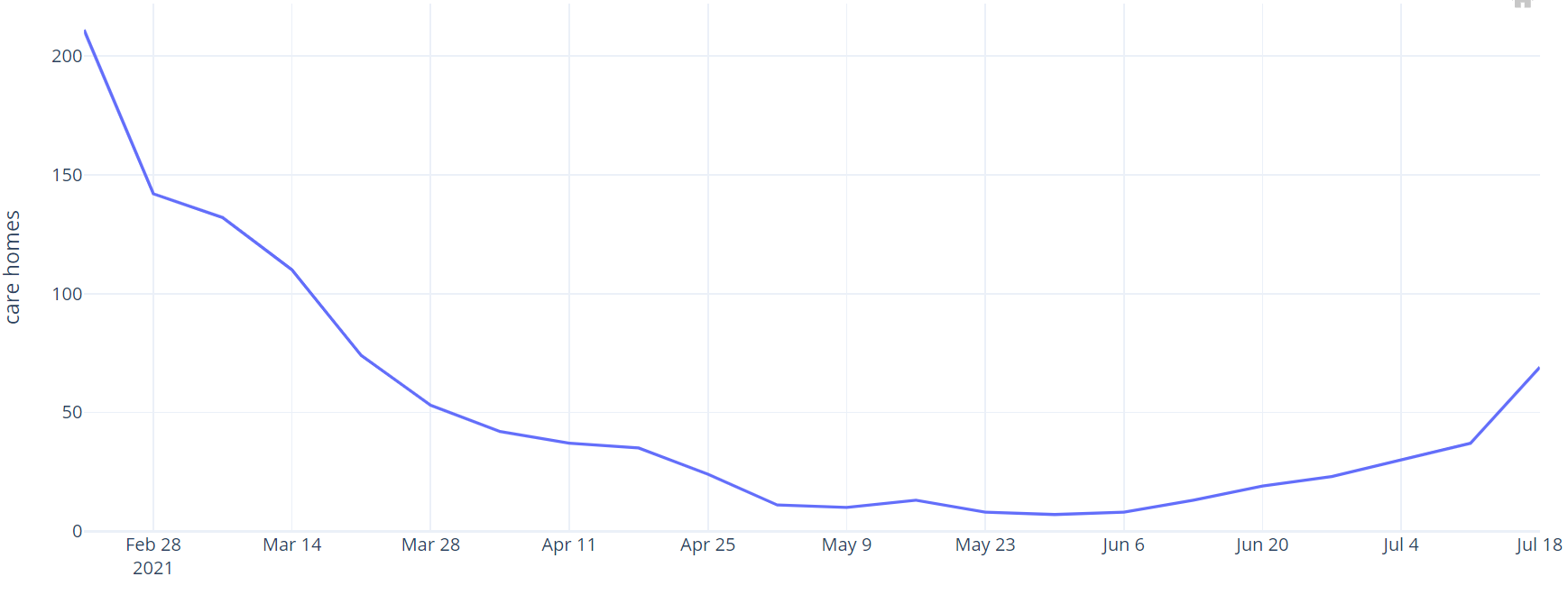
What is the situation with education, children and young adults?
Childcare settings
The latest National Situation Background Assessment Recommendation (SBAR) report covering the week of 12 July to 18 July reported that the incidence of clusters in child care settings remains low.
2* new clusters were reported last week across 2 health boards, compared to 3 new clusters reported the previous week.
Schools
There were 74* new and 111* ongoing clusters associated with schools reported by IMTs last week.
88** are attributed to school settings and 78** to household, social or extra-curricular activities. Source: National SBAR.
*Figures do not include Conwy or Cwm Taf Morgannwg data.
** Figures do not include Gwynedd, Conwy or Cwm Taf Morgannwg data.
Weekly COVID-19 per 100,000 population for school age children and young adults incidence in Wales (data as at 1pm 21 July 2021)

Schools with more than one COVID-19 case identified within the last 21 days, excluding 305 schools with 1 COVID-19 case
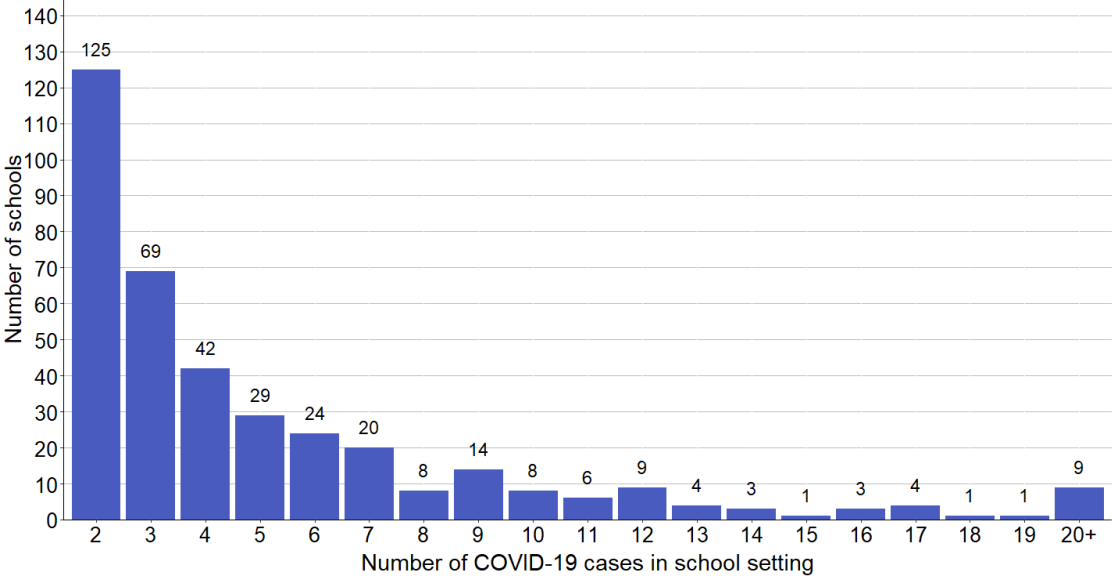
Epidemiological curve of cases in all staff and pupils linked to a school between 22 February 2021 and 19 July 2021 for all Wales maintained schools
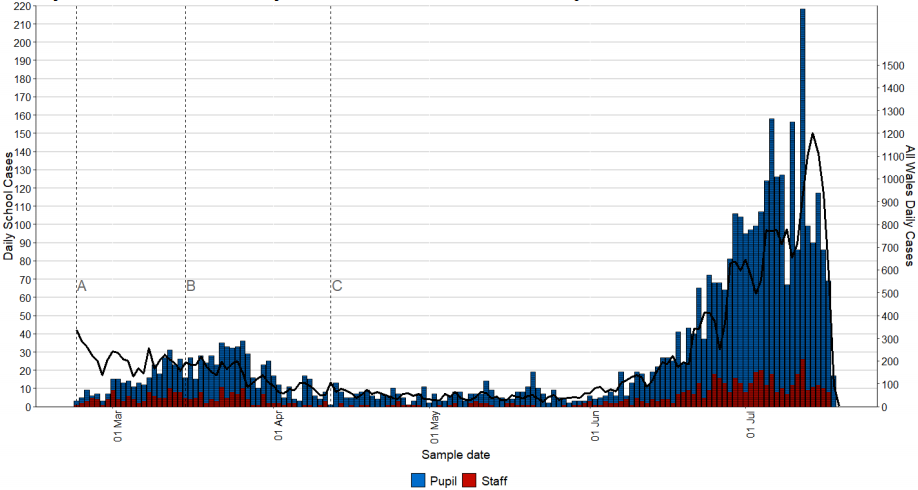
School Attendance
An average of 77% of all pupils were present in school over the week of 12 July to 16 July Source: Stats Wales.
Absence due to COVID
Absence due to a COVID-19 related reason was similar between primary and secondary age pupils up until mid June where absences in secondary schools started to increase at a faster rate. The latest data shows that in July the percentage of pupils absent in secondary schools is two to three times that in primary schools. COVID-19 related absence was only available on a consistent basis from April onwards. Source: Stats Wales.
Pupils present by day in Wales, from 7 September 2020
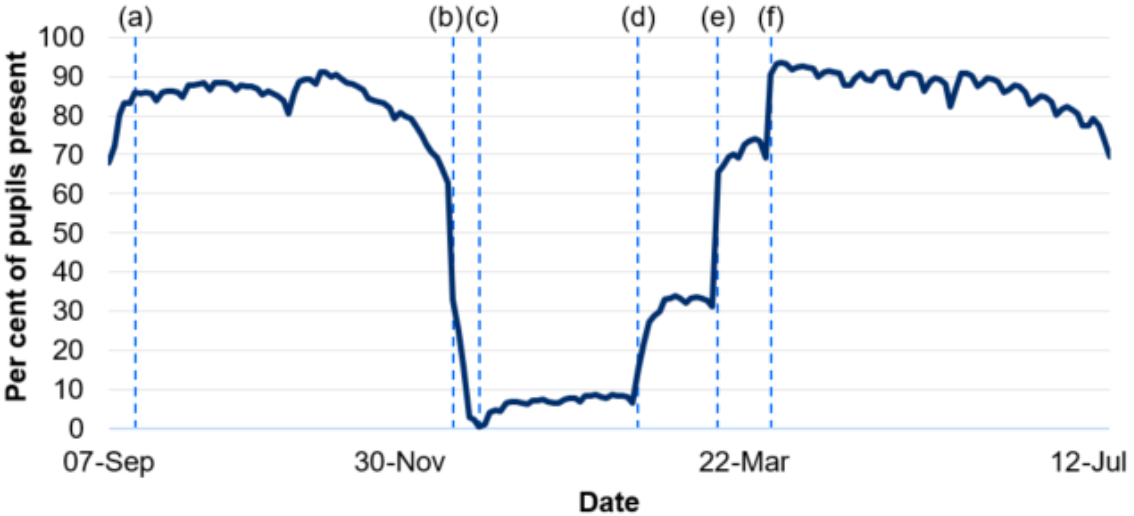
Further Education (FE)
The latest National SBAR reported no new clusters associated with FE settings last week. Source: National SBAR.
Higher Education Institutions (HEIs)
According to the National SBAR, the incidence of new clusters associated with HE settings remains low, with no IMTs reporting new clusters this week compared to 3 new clusters reported last week. Source National SBAR.
Please note: Due to accuracy & timeliness limitations with the capability of our surveillance systems, distinguishing exact case associations between children over 19, school staff and/or family members is currently not possible. We are looking to develop this with local health protection officers.
Pupils absent due to a COVID-19 by day and phase 14 July 2021
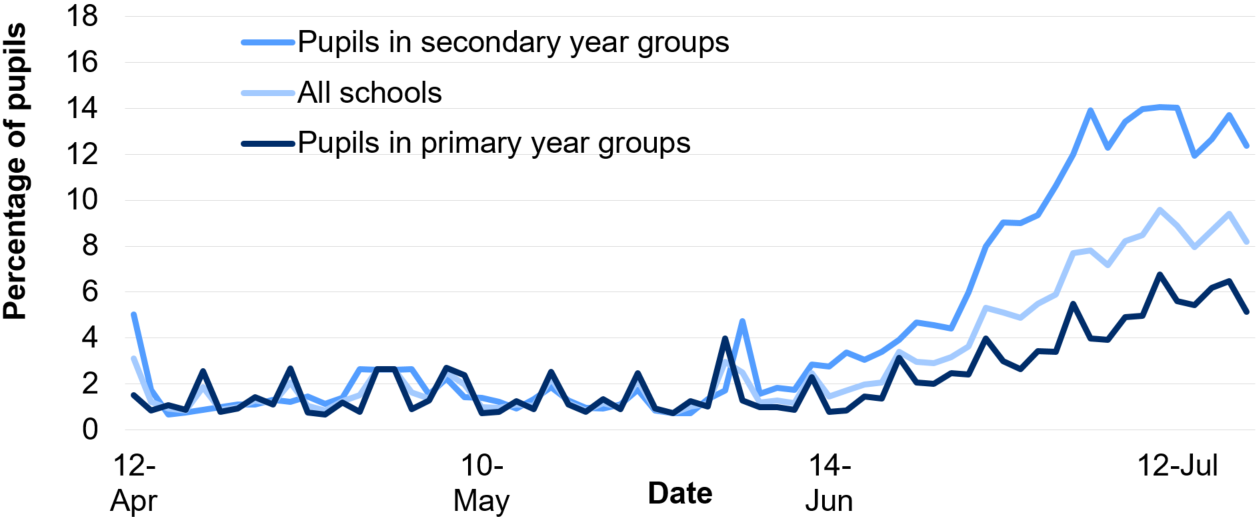
Please note: Due to accuracy & timeliness limitations with the capability of our surveillance systems, distinguishing exact case associations between children over 19, school staff and/or family members is currently not possible. We are looking to develop this with local health protection officers.
What is the situation with arriving travellers
There is a 20% increase in overall travellers. The positivity rate amongst green arrivals increased to 1.31%. There are 33 positive cases from Spain including the Balearics.
Fully vaccinated arrivals from amber list countries will no longer be required to isolate at home. Arrivals from France will still be required to isolate due to concerns over the Beta Variant.
There were 5,853 total travellers for this week (4,895 last week):
- Amber: 3,892 (2,890 last week)
- Red: 167 (211 last week)
- Green: 1752 (758 for last week)
There were 44 positive arrivals (0.75%). In the same period 553 (465 last week) of 5,853 travellers marked themselves as exempt (9.4%).
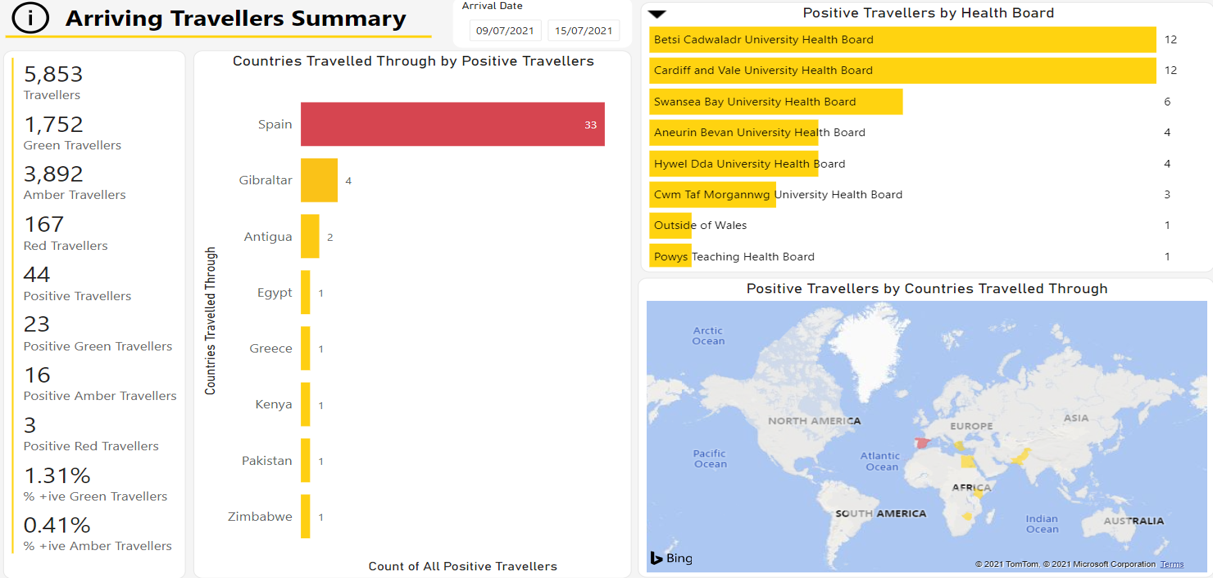
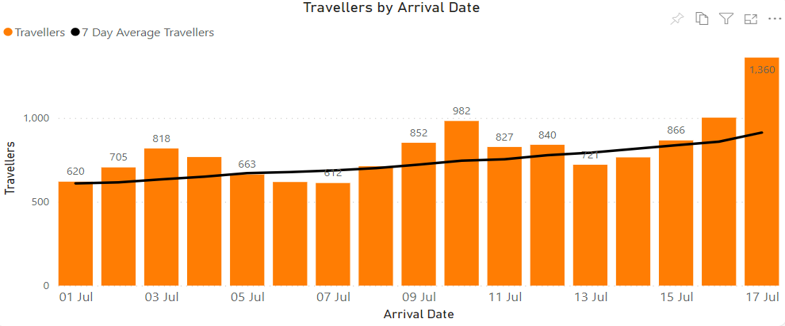
Source: Home Office
Please note that the data provided by the Home Office is derived from Passenger Locator Forms (PLF) which are self-completed by travellers. As such, data may contain inaccuracies. Due to the limitations associated with data capture and legislation, some minor discrepancies may be present in the data.
Mobility data, adherence and UK comparison
Mobility data by location of trip
The latest mobility data shows increases in mobility compared to the previous week. Mobility had decreased overall from half term week (end of May/early June) – but is starting to increase again. The baseline for much of the data is during January to February 2020 and changes are relative to that period. It is not possible to determine if mobility is higher/lower than would have been expected prior to the pandemic as data for 2019 or earlier years is not published.
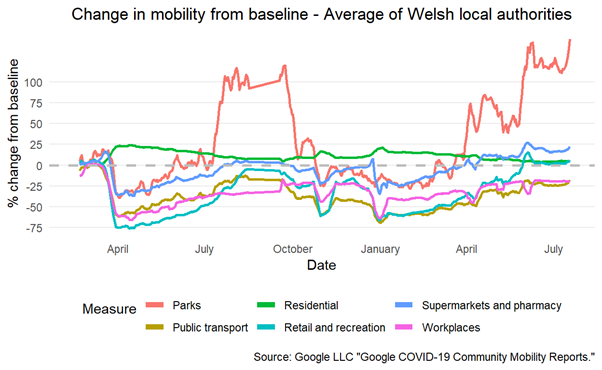
Adherence
The most recent IPSOS MORI data for the period 2 – 5 July for Wales shows that those who reported making essential trips only was the lowest since the survey began in March 2020. Other measures are similar to the last survey wave. It should be noted that this is self-reported adherence and will be affected by individuals’ understanding of the rules and circumstances that apply to them.
The latest results from the Public Engagement Survey on Health and Wellbeing during Coronavirus Measures (21 to 27 June) shows that 85% of people said they understand current restrictions in Wales ‘very well’ or ‘fairly well’ and that 83% of people said they were following coronavirus restrictions ‘completely’ or with 'majority compliance'.
Results from the Coronavirus (COVID-19) Infection Survey, 11 July to 17 July
The percentage of people testing positive has continued to increase over one week in England, Wales and Northern Ireland and over two weeks in Scotland. The trend is uncertain in Scotland in the most recent week.
It is estimated that an average of 14,400 people in Wales had COVID-19 (95% credible interval: 9,500 to 14,400), equating to around 1 in 210 people or 0.47% of the community population (up from 0.28% last week). This compares to around 1 in 75 people in England, around 1 in 80 people in Scotland, and around 1 in 170 people in Northern Ireland.
Source: Office for National Statistics COVID-19 Infection Survey.
Positivity rates (%) across UK countries up to 17 July 2021
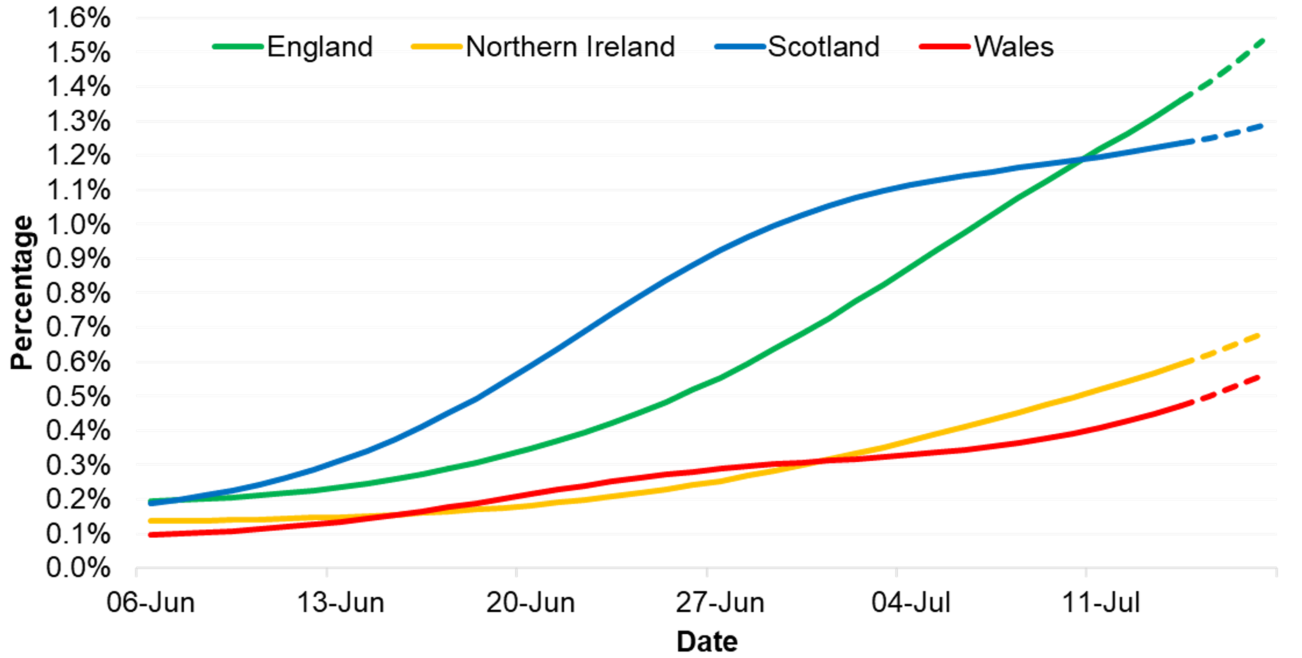
Vaccine and immunity status
Vaccination and antibody status of individuals aged 16 and over in Wales
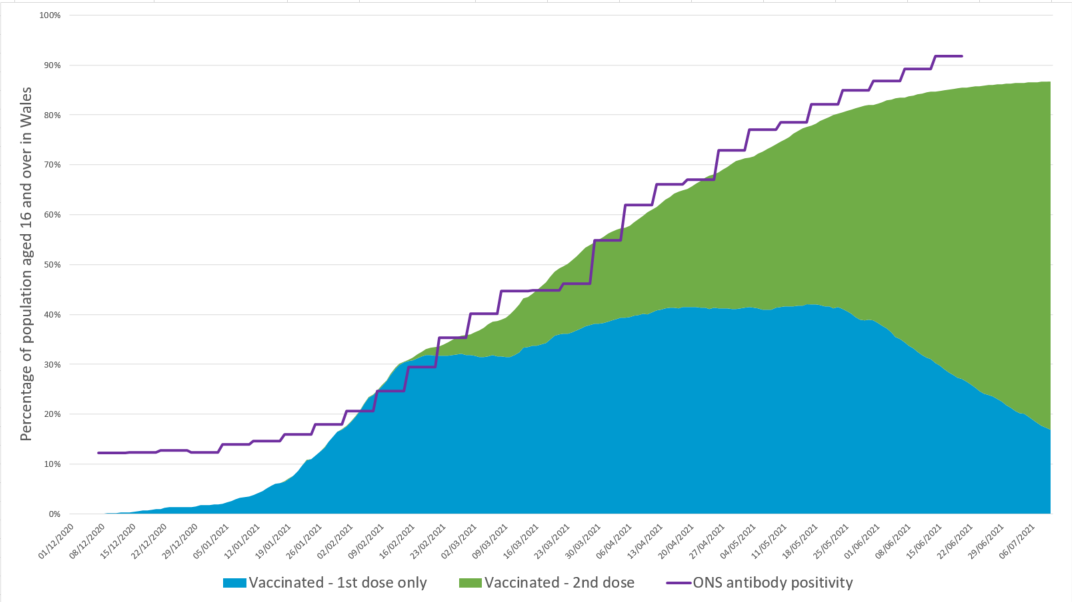
Immunity estimates and antibody status of individuals aged 16 and over in Wales
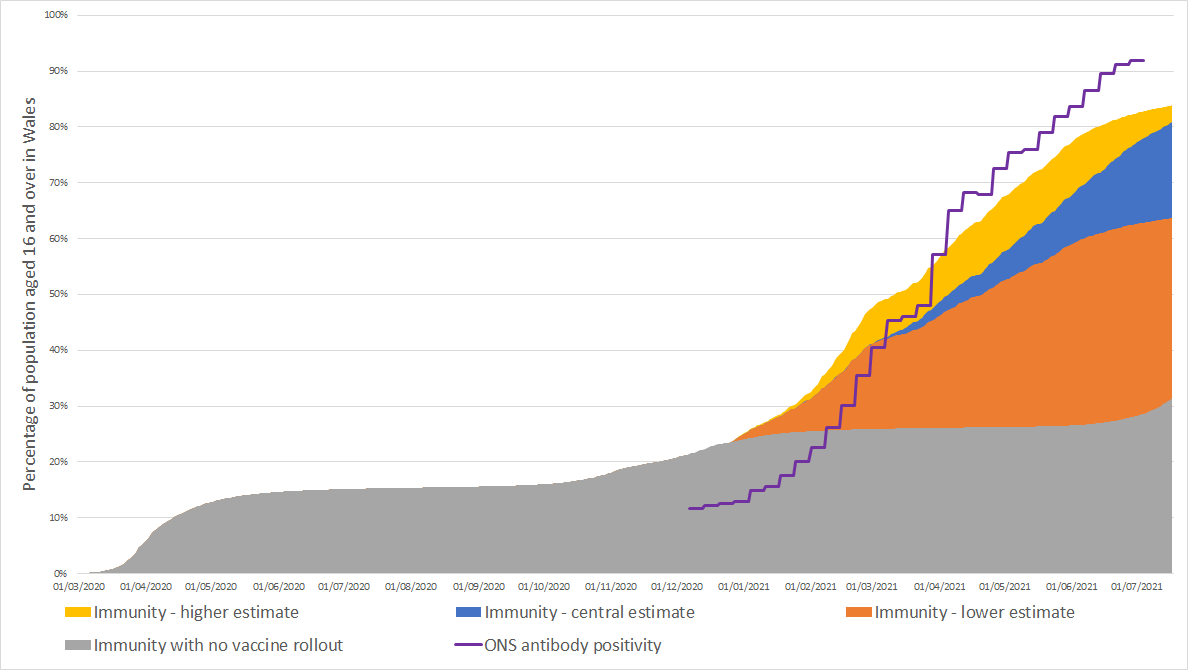
The COVID-19 vaccination rollout continues to progress well in Wales. As at 17 July 2021, 87% of people aged 16 and over had received at least one COVID-19 vaccine dose in Wales. 14% of people aged 16 and over had exactly one vaccine dose and 73% were fully vaccinated. Uptake of first doses has slowed since the final priority group was reached.
Between 28 June and 4 July 2021, the ONS COVID-19 Infection Survey estimated that 92.6% of the community population aged 16 and over in Wales tested positive for COVID-19 antibodies.
As at 17 July 2021, it was estimated that 81% of people aged 16 and over in Wales had some immunity against COVID-19 infection. The lower and higher estimates of immunity are 64% and 84% of people aged 16 and over in Wales. If no vaccines had been administered, it is estimated that 31% of people aged 16 and over would be immune. These estimates assume 84% of natural infections lead to immunity, but do not account for waning immunity (SIREN study paper, The Lancet, published 9 April 2021).
It is currently estimated that over 80% (may be closer to 90%) of the population, spread evenly across Wales, must be immune to COVID-19 before population immunity effects would be observed (TAG advice on the Delta variant, published 18 June 2021). Note that the immunity estimate of 81% is for individuals aged 16 and over, not the total Wales population, and varies across age groups.
Differences between antibody presence and immunity estimates include:
- ONS antibody estimates are based on study participants who have volunteered for the study and estimates are extrapolated
- ONS estimates are based on the 16+ community population, which excludes people in care homes or hospitals. Immunity estimates are based on the whole 16+ Wales population
- while antibody protection doesn’t equal immunity from infection, it does give a useful indication of the level of protection from infection in the Welsh population
- antibody estimates use 2019 mid-year population estimates while we use 2020 estimates
Source: ONS COVID-19 Infection Survey, PHW, SPI-M, Swansea University modelling
What does the situation look like going forward?
Based on the current rates observed with current restrictions:
Cases
The probability of incidence reaching greater than 200 per 100,000 between 1 August and 7 August is above 80% for Conwy, Denbighshire and Bridgend. The figure illustrates the probability (between 0 – 100%) of incidence being greater than 200 per 100,000. Source: Imperial College London.
Probability of greater than 100 per 100,000 cases by local authority
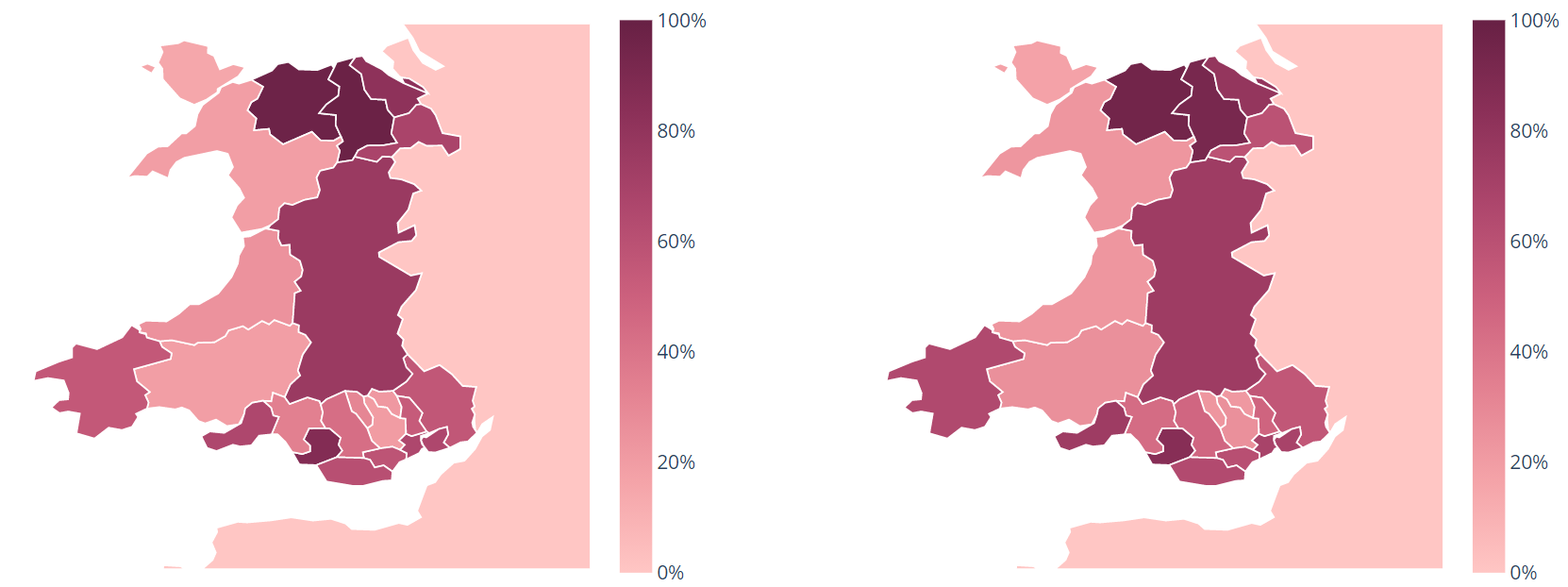
25 to 31 July and 1 August to 7 August
Deaths per day
SPI-M's consensus view is that the number of deaths in Wales will remain low over the next four weeks. Source: Modelled medium term projections, SAGE/SPI-M, 19 July.
Hospitalisations per day
Projected to increase to just under 30 per day over the next four weeks before levelling off. Source: Modelled medium term projections, SAGE/SPI-M, 19 July.
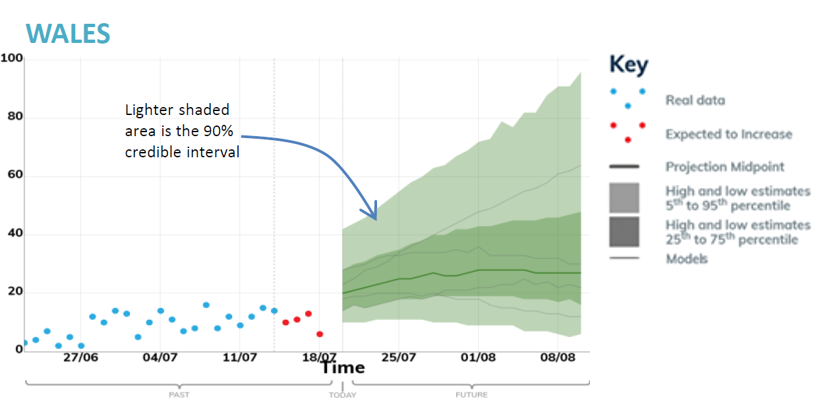
These projections are based on current trends and will not fully reflect the impact of policy or behavioural changes over the past two to three weeks. The projections include the impact of vaccines, but cannot capture any future increases in transmission resulting from new variants. They are not forecasts or predictions.
Key risks and sources
Key risks
Transmissions, incidence and prevalence
Overall transmission, percentage of people testing positive is rapidly increasing since last week.
Trends vary across health boards and local authorities.
NHS Capacity
COVID-19 pressure on the NHS has been steadily increasing over recent weeks. Invasive ventilated bed occupancy and hospital bed occupancy for COVID-19 related patients is increasing.
Mortality
Low numbers of deaths in the most recent week, although this has increased.
Variants
Wales has 7,817 confirmed cases of the more transmissible Delta variant (an increase of 2,216 from the previous week). Delta remains the dominant variant of COVID-19 in Wales.
Immunity and vaccines
4.24 million (+0.11 million) doses of COVID-19 vaccine have been given in Wales, of which 2.28 (+0.01) million were first doses and 1.96 million (+0.10) were second doses. Around 80% of people aged 16 and over have some immunity in Wales.
International
There is an increase in travellers numbers this week, however positive rates are relatively low.
